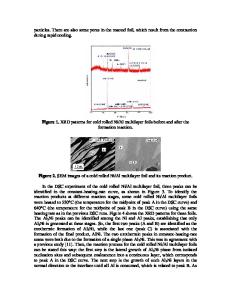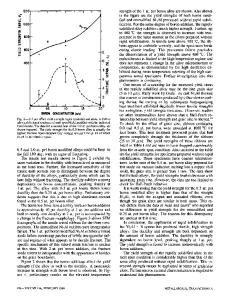Ductility of cold-rolled and recrystallized Ni 3 Al foils
- PDF / 2,896,697 Bytes
- 9 Pages / 612 x 792 pts (letter) Page_size
- 95 Downloads / 398 Views
The room-temperature ductility of 95% cold-rolled and recrystallized Ni3Al (Ni–24.0 at.% Al) foils was examined as a function of heat-treatment conditions. The cold-rolled, diffused Goss texture changed to a complicated, transitional texture in the early stage of grain growth and then returned to a similar diffused Goss texture in the late stage. With the texture evolution, the total area fraction of the tough grain boundaries (GBs) such as ⌺1, ⌺3, and ⌺9 increased from 0.23–0.38 in the early stage to 0.56–0.73 in the late stage. Tensile and bending tests revealed that the ductility was drastically improved with the grain growth. The foils in the early stage fractured without showing yielding. In contrast, the foils in the late stage were very ductile, and the tensile elongation increased to 10% with the grain growth. It was confirmed that there was no in-plane anisotropy in ductility. The ductility improvement with the grain growth was ascribed to the increase in the area fraction of the tough GBs.
I. INTRODUCTION
Recently, we have developed thin boron-free Ni3Al foils for high-temperature applications such as automotive catalyst supports, micro-chemical reactors, and thermal protection panels.1–5 The foils are fabricated by cold rolling of single crystals without intermediate annealing: the thinnest foils obtained so far are 23 m in thickness with 99% reduction.1,2,4 Because of some bending ductility,2,3,6 a corrugated structure has been successfully made from the cold-rolled foils,7 which is useful for the above-mentioned applications. However, the ductility of the cold-rolled foils is limited. First, they exhibit no macroscopic tensile elongation, though they exhibit very small local deformation.2,8 Second, a large in-plane anisotropy exists in bending; it is possible to bend them about the transverse direction (TD) of cold rolling, but this is difficult about the rolling direction (RD).6 To form the foils into various product shapes, it is necessary to overcome such a limitation in the ductility. In a previous paper,1 we reported that the recrystallized foils possess some tensile ductility (3– 14.6%) along the RD at room temperature in air, which demonstrates that ductility improvement can be achieved by recrystallization. However, the suitable heattreatment conditions for the ductility improvement are
a)
Address all correspondence to this author. e-mail: [email protected] DOI: 10.1557/JMR.2005.0142 1054
http://journals.cambridge.org
J. Mater. Res., Vol. 20, No. 4, Apr 2005 Downloaded: 09 Apr 2015
not yet clear. In addition, the tensile ductility along the TD has not yet been examined. The main purpose of this paper is to examine the room-temperature ductility of the cold-rolled and recrystallized Ni3Al foils in terms of the heat-treatment conditions and the in-plane anisotropy in the ductility.
II. EXPERIMENTAL
Thin Ni3Al foil (45 mm in width and 105 m in thickness) was fabricated by 95% cold rolling of an investmentcast, single-crystalline sheet with a nominal composition of binary Ni–24 at
Data Loading...











